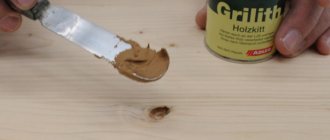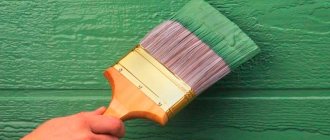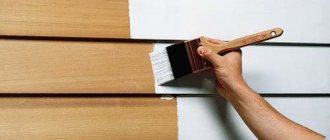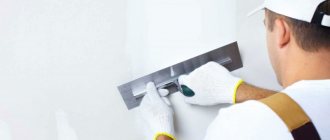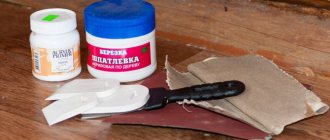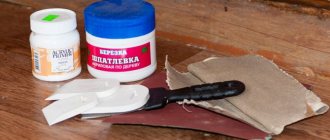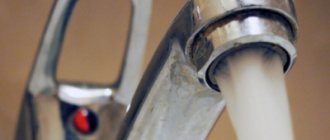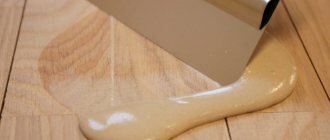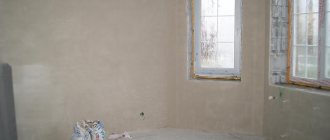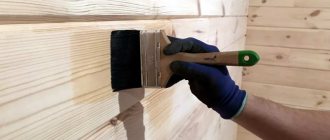Unfixed cracks are slowly but surely killing wood.
Types of wood putties: why such a wide selection of materials
The main function of this material is to hide defects. But, since the violations of the base are different, as are the types of wood, and the operating conditions of a particular product are also not similar to each other, there are different types of putty mixtures. Let's get acquainted with their types in more detail.
Gypsum-based putties
As you know, gypsum is not friendly with moisture, therefore, in terms of strength and elasticity, the gypsum composition is inferior to other mixtures.
The advantages of gypsum compositions are their vapor permeability, which will preserve the microclimate in the room, and the cost of the material is low in comparison with others.
It is easy to treat large areas of the surface with gypsum putty.
If the question is how to putty on a wooden surface in a dry room, then you can safely buy a gypsum compound.
Acrylic wood putty
Acrylic putties are not afraid of moisture and temperature changes, and they are not afraid of mechanical loads. This is ideal for the floor, but the mixtures can also be used outside the building.
Acrylic is highly elastic; it is a good wood putty for filling deep defects, small cracks, and wood pores. There is no shrinkage: once the mixture was applied, it remained that way after drying.
The service life is stated to be from three to ten years, but prices for products containing acrylic are noticeably higher
Epoxy putty for wood
Epoxy is used to repair wooden surfaces: doors, window frames, columns, and beams are restored with this mixture. Epoxy putty does not react to moisture and is a highly durable inclusion once it hardens.
Epoxy putty is ideal for working with wood
This material contains two elements that need to be mixed before work: they allow the mass to set quickly. The surface with epoxy can be easily sanded and painted; it will not be affected by water or chemical solvents.
But you shouldn’t apply stain; the appearance of the treated area will be spoiled.
Oil-based putties
It is clear that the composition contains oils and solvents. The product is used to treat the surface of building facades before painting them.
This composition is suitable for outdoor use due to its characteristics: water resistance and resistance to adverse environmental influences.
Manufacturers have selected the optimal composition for their products
Such a surface will not crack or crumble. Thanks to manufacturers, you can find a mixture of the desired color, even with the ability to imitate a wooden texture.
Other varieties
Wooden putty is safe for health if it does not contain solvents. We are talking about an aqueous composition that boasts plasticity and elasticity, as well as the absence of a pungent odor. Excess material is wiped off with a damp cloth.
Water-based putty does not harden for a long time in a container, which makes its shelf life quite long
This is a composition with a high level of adhesion, so it is effective on different surfaces.
In addition, we can add that when finishing they use nitro putty, adhesive, latex.
The main components of nitro putty are cellulose, its resins, ethers, plasticizers
Oil based
The only type of wood putty suitable for outdoor work; it can be used outdoors even without further varnishing or painting. Suitable for processing wooden facades.
It has strong water-repellent properties, is not afraid of ultraviolet radiation, exposure to open air, including sea air. Available in packaging from 500 grams to 15 kg.
Leading manufacturers: tested by time and users
The modern market offers a wide range of good domestic and imported mixtures produced by famous and reliable brands.
Wood putties from Tikkuril are in demand. This is a Finnish company that offers its products at high prices, which are fully justified by the quality.
Tikkurula has been on top for a long time
Famous for its quality products. Their products are inexpensive, but the quality does not suffer from this.
Lakra has decent products
Domestic wood putty is cheaper than many compounds from competitors, but the quality of the supplied products is quite high.
Eurotex is also considered worthy of mention.
Polymer
Polymer, also known as acrylic wood putty, is currently more common than others. This is due to its relative cheapness, durability, ease of use, good water-repellent properties, elasticity, and low shrinkage coefficient when drying.
Thanks to the modifiers it contains, it is suitable for both living rooms and rooms with high humidity (bathroom, toilets, sauna, kitchen). Also good for restoration of parquet and floor boards.
How to choose wood putty: don’t waste money
How to putty wood, that is the question. We select suitable compositions for interior and exterior work.
Wood putty for exterior use and its effect
For exterior work, they prefer to use thermal and moisture-resistant wood putty. The walls of the building are exposed to alternating temperatures, precipitation, and ultraviolet radiation. Therefore, in this case, we consider compositions not only with easy application, but also with elasticity.
Acrylic compounds are suitable, protecting wood from fire and preventing it from deteriorating from outdoor temperatures.
Epoxy putties are two-component, based on petroleum resin, pigment additives, and plasticizers. These are mixtures that qualitatively fill defects and are resistant to deformation and destruction.
Epoxy deserves special consideration as an exterior finishing product as a base coat.
The oil mixture will retain oils, chalk, water and plasticizers. For outdoor coverings, this is a fairly resistant material, durable and reliable. Those who are wondering how long it takes wood putty to dry should read the instructions directly on the container. The oil composition takes more than a day to dry.
Wood putty for interior work
It's not just the walls that are plastered inside houses and apartments. This is a material for floors, ceilings, doors, which allows you to perform basic finishing of the element. Any putty must meet a number of requirements: plasticity, suitable consistency, strength, good adhesion to wood, gradual hardening and avoidance of cracks.
For home work, you can use epoxy, polymer, acrylic
Epoxy is used to seal deep defects and level surfaces. No special tools are required for the job, and sanding is easy and relaxed. If you are faced with a dilemma about which wood putty to choose for the floor, then you should first of all think about epoxy.
Plaster in all rooms, except the bathroom and kitchen, is good because it both absorbs and releases excess moisture into the air and does not negatively affect the microclimate of the room
Polymer compositions are universal; they mask seams, seal deep cracks, and perform finishing work for subsequent coatings with paints and varnishes. This is the same composition that is good for correcting defects on frames, ceilings, door frames and the door itself. This composition is not used for working with floors.
Waterproof mixtures are designed for use in the bathroom and kitchen.
Application rules
To make the coating look more natural after treatment, you need to follow certain conditions when working:
- It is necessary to cover all the cracks in the wood outdoors at a temperature of at least five degrees Celsius, otherwise the composition will turn out to be too viscous and will not be able to fill the cracks and crevices well. Air humidity at this moment should exceed 75 percent.
- The surface to be treated must be well prepared in advance - clean all the voids that will be filled with the mixture, wipe off the dust with a damp cloth, remove the old varnish coating if necessary and clean the surface with sandpaper.
- The putty should be applied with a stainless steel spatula or a simple plastic spatula.
- If you need to fill a large crack with a diameter of one centimeter with the mixture, then it is better to putty it in several layers at once, allowing each previous layer to dry well. The thickness of each layer should not be more than 2-3 millimeters. Drying time directly depends on the composition of the putty (it is best to study the instructions on the package).
How to use putty materials
Let's consider the main areas of application of this material. This is the elimination of defects on a wooden floor, sealing various kinds of cracks, imitation of wood texture on the surface.
Putty for wooden floors
Putty for wooden floors must contain components that will prevent the material from quickly wearing out from mechanical stress.
If you try to save money, then after 2-3 years the sealed surface will deteriorate and crack
Aqueous, paste-like and gel-like compositions are suitable for the floor. If the product contains fiber fiber, then the durability of the finished coating is guaranteed.
Nitro-based putty will also be stable. In the composition you need to look for cellulose ether components, acetone, resins. Products containing wood flour have a high level of adhesion to any type of wood. Nitro putties, for all their positive qualities, have a rather pungent odor.
Homemade compounds mixed with wood flour ideally fill cracks and seams on wooden floors
Wood putty: what to use to fill cracks
A small gap in a wooden floor is sealed either with a putty of a suitable color, or with a composition of any shade, followed by priming and painting the floor.
Cracks 3-4 mm in size are sealed with acrylic products; larger defects should not be touched, as the finished material will crumble and fall out.
The solvent-based product is well suited for sealing cracks up to 1 cm, and can even eliminate defects on heated floors.
Oil compositions for eliminating narrow cracks should be mixed with chalk, and for wide flaws - with wood dust.
Imitation of wood from putty as a way to decorate the surface
To make imitation wood, a number of tools are required. You need to get a palette knife, a textured roller, a roller with a picture of a wood cut, several types of rubber spatula, and a stencil.
Acrylic, gypsum and silicone bases are suitable for interior finishing.
Beautiful imitation wood made of putty
Grinding technology
It is not recommended to process the entire area of the disc, as beginners often do, resulting in leaving marks from the circle on the surface. Only the upper sector of the nozzle is used for grinding. It is necessary to move the angle grinder along the grain of the wood. This simple technique will help you leave no traces at all or reduce them to a minimum. The main thing is to find a comfortable support point so that your hands don’t get tired quickly.
The process of sanding wooden products (including floors) with a grinder can be divided into six stages.
Coating preparation
If traces of varnish or paint are present, they must be removed before sanding. To do this, you will need an angle grinder with a special stripping accessory.
Primary grinding
For this stage of processing, grinding and polishing discs are used. If you don’t have such an accessory at hand, you can use an ordinary circle to which coarse-grained emery is securely attached.
Fine grinding
For such grinding of wood onto a grinder disc, it is preferable to use a flap version, for example, P80 SMT, with a low grit level.
Filling gaps
When the initial sanding process is completed, it is time for other work on the wood surface. Doing everything yourself is not difficult, but it will take a long time, since it is almost “jewelry” work.
So, the task is to eliminate the smallest defects:
- It will be necessary to use a nozzle with a minimum grain size, which the operator needs to go through the gaps.
- The most inaccessible places will have to be processed manually.
- It is necessary to remove the resulting dust from time to time to improve visibility.
- Apply putty to the surface.
Recipes for making your own wood putty
If you wish, you can make a putty mixture with your own hands, which will not be inferior in quality to store-bought ones. It's all about good, quality ingredients.
The most popular component is crushed chalk, which must be mixed with PVA glue until it becomes sour cream. It is permissible to add small sawdust.
This product will take a day to dry.
The second method is to dilute the chalk with water-soluble acrylic varnish. The paste should be moderately liquid.
Important! Homemade mixtures are not prepared in large volumes, and unevenness and smudges are removed immediately.
What other materials are used for woodworking?
In addition to putty products, other compounds are also used for working with wood. Their list includes primer and plaster. Each product has its own functions and characteristics.
Primer for wood
Primer is a mandatory material for use in many areas of surface treatment. It is designed to bind substances on different layers of the surface, which creates a waterproof varnish film. This is the protection of the tree from the negative effects of external factors.
Important! The primer seriously saves the consumption of materials, and, therefore, finances.
But all this will only work if the primer is of high quality and suitable for woodworking. A soluble primer protects the material from destruction, and a waterproof primer protects it from moisture.
There are oil and acrylic compositions. In any case, they will be the base layer for subsequent finishing.
Wood plaster
Plaster protects the wood from rotting, but the condition is to first coat the surface with antiseptic compounds, which must dry completely.
A plastered wall resists the appearance of mold if the initial humidity threshold does not exceed 12%. Plaster protects the surface from termites and rodents.
Use lime, cement, lime-gypsum, gypsum plaster
Required Tools
The process of decorating wooden products has several stages: first, the surface must be properly prepared, then it can be puttied and painted. But depending on the type of materials that will be painted, the technology is somewhat different. The general list of necessary tools for painting includes:
- paint of the desired color and composition;
- brushes;
- putty and primer;
- putty knife;
- “skin” (sandpaper);
- construction hair dryer or cleaning agent.
We will need a hair dryer or a cleaning agent to remove the old paint layer from the product.
You should be very careful, because the temperature of heating the surface with a hairdryer is quite high, which can negatively affect your wooden object. Therefore, if you are going to repair an antique item, it is better to use chemical cleaners.
How much does wood putty cost - price review
After familiarizing yourself with the work being carried out and the performance characteristics of the materials, it’s time to familiarize yourself with the prices for popular types of putties made by different manufacturers.
| Name | Characteristic | Price for June 2022, rub. |
| TEX on wood Profi | Ready-made latex putty; room type: dry; mixture consumption (1 mm layer): 1–4.70 l/m²; mixture consumption (1 mm layer): 0.60–2.80 kg/m² | 55 |
| VGT acrylic on wood “Extra” | Ready-made acrylic putty; type of putty: finishing; room type: dry and wet; mixture consumption (1 mm layer): 0.50-1.40 kg/m² | 51 |
| PRESTIGE for wood | Ready-made acrylic putty; for interior work; processing material: wood, stone, brick, concrete | 46 |
| Acrylic varnish on wood | Ready-made acrylic putty; type of putty: universal; room type: dry and wet | 131 |
| Faktura on wood | Ready-made acrylic putty; type of putty: finishing; room type: dry and wet; mixture consumption (1 mm layer): 2 kg/m² | 64 |
| Berger-Seidle Pafuki Super | Nitrocellulose putty; layer thickness: 2 mm; for interior work; processing material: wood | 1450 |
| Borma Wachs Holzmasse | Ready-made nitrocellulose putty; drying time 12 hours; for internal and external works; processing material: wood | 402 |
Treat wooden surfaces correctly, then the service life of the product will extend significantly, and the room will remain beautiful.
